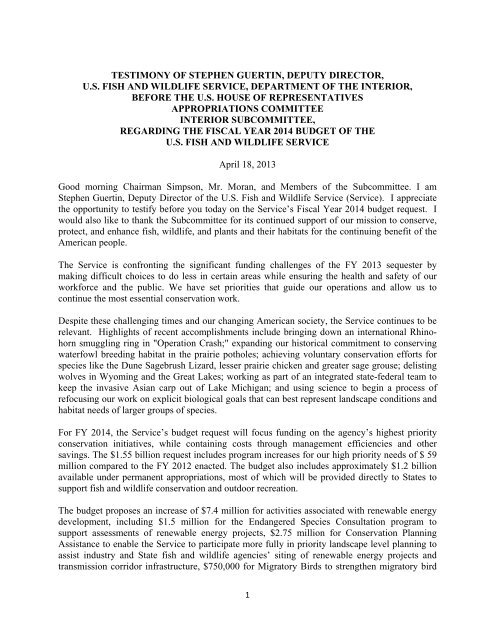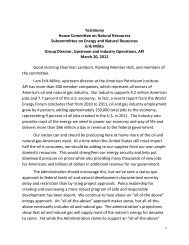Mr. Stephen D. Guertin - The House Committee on Natural Resources
Mr. Stephen D. Guertin - The House Committee on Natural Resources
Mr. Stephen D. Guertin - The House Committee on Natural Resources
You also want an ePaper? Increase the reach of your titles
YUMPU automatically turns print PDFs into web optimized ePapers that Google loves.
TESTIMONY OF STEPHEN GUERTIN, DEPUTY DIRECTOR,<br />
U.S. FISH AND WILDLIFE SERVICE, DEPARTMENT OF THE INTERIOR,<br />
BEFORE THE U.S. HOUSE OF REPRESENTATIVES<br />
APPROPRIATIONS COMMITTEE<br />
INTERIOR SUBCOMMITTEE,<br />
REGARDING THE FISCAL YEAR 2014 BUDGET OF THE<br />
U.S. FISH AND WILDLIFE SERVICE<br />
April 18, 2013<br />
Good morning Chairman Simps<strong>on</strong>, <str<strong>on</strong>g>Mr</str<strong>on</strong>g>. Moran, and Members of the Subcommittee. I am<br />
<str<strong>on</strong>g>Stephen</str<strong>on</strong>g> <str<strong>on</strong>g>Guertin</str<strong>on</strong>g>, Deputy Director of the U.S. Fish and Wildlife Service (Service). I appreciate<br />
the opportunity to testify before you today <strong>on</strong> the Service’s Fiscal Year 2014 budget request. I<br />
would also like to thank the Subcommittee for its c<strong>on</strong>tinued support of our missi<strong>on</strong> to c<strong>on</strong>serve,<br />
protect, and enhance fish, wildlife, and plants and their habitats for the c<strong>on</strong>tinuing benefit of the<br />
American people.<br />
<str<strong>on</strong>g>The</str<strong>on</strong>g> Service is c<strong>on</strong>fr<strong>on</strong>ting the significant funding challenges of the FY 2013 sequester by<br />
making difficult choices to do less in certain areas while ensuring the health and safety of our<br />
workforce and the public. We have set priorities that guide our operati<strong>on</strong>s and allow us to<br />
c<strong>on</strong>tinue the most essential c<strong>on</strong>servati<strong>on</strong> work.<br />
Despite these challenging times and our changing American society, the Service c<strong>on</strong>tinues to be<br />
relevant. Highlights of recent accomplishments include bringing down an internati<strong>on</strong>al Rhinohorn<br />
smuggling ring in "Operati<strong>on</strong> Crash;" expanding our historical commitment to c<strong>on</strong>serving<br />
waterfowl breeding habitat in the prairie potholes; achieving voluntary c<strong>on</strong>servati<strong>on</strong> efforts for<br />
species like the Dune Sagebrush Lizard, lesser prairie chicken and greater sage grouse; delisting<br />
wolves in Wyoming and the Great Lakes; working as part of an integrated state-federal team to<br />
keep the invasive Asian carp out of Lake Michigan; and using science to begin a process of<br />
refocusing our work <strong>on</strong> explicit biological goals that can best represent landscape c<strong>on</strong>diti<strong>on</strong>s and<br />
habitat needs of larger groups of species.<br />
For FY 2014, the Service’s budget request will focus funding <strong>on</strong> the agency’s highest priority<br />
c<strong>on</strong>servati<strong>on</strong> initiatives, while c<strong>on</strong>taining costs through management efficiencies and other<br />
savings. <str<strong>on</strong>g>The</str<strong>on</strong>g> $1.55 billi<strong>on</strong> request includes program increases for our high priority needs of $ 59<br />
milli<strong>on</strong> compared to the FY 2012 enacted. <str<strong>on</strong>g>The</str<strong>on</strong>g> budget also includes approximately $1.2 billi<strong>on</strong><br />
available under permanent appropriati<strong>on</strong>s, most of which will be provided directly to States to<br />
support fish and wildlife c<strong>on</strong>servati<strong>on</strong> and outdoor recreati<strong>on</strong>.<br />
<str<strong>on</strong>g>The</str<strong>on</strong>g> budget proposes an increase of $7.4 milli<strong>on</strong> for activities associated with renewable energy<br />
development, including $1.5 milli<strong>on</strong> for the Endangered Species C<strong>on</strong>sultati<strong>on</strong> program to<br />
support assessments of renewable energy projects, $2.75 milli<strong>on</strong> for C<strong>on</strong>servati<strong>on</strong> Planning<br />
Assistance to enable the Service to participate more fully in priority landscape level planning to<br />
assist industry and State fish and wildlife agencies’ siting of renewable energy projects and<br />
transmissi<strong>on</strong> corridor infrastructure, $750,000 for Migratory Birds to strengthen migratory bird<br />
1
c<strong>on</strong>servati<strong>on</strong> in areas with wind developments, $1 milli<strong>on</strong> for enforcement of wildlife protecti<strong>on</strong><br />
laws to lessen the impact of energy development <strong>on</strong> wildlife resources, and $1.4 milli<strong>on</strong> for<br />
scientific research to identify impacts from energy transmissi<strong>on</strong> infrastructure development in<br />
the American west and to inform mitigati<strong>on</strong> strategies.<br />
This budget request maintains the Service’s commitment to the stewardship of America’s Great<br />
Outdoors. Understanding the importance of training the next generati<strong>on</strong> of c<strong>on</strong>servati<strong>on</strong> leaders,<br />
the Service is requesting $15.9 milli<strong>on</strong> to support Youth in the Great Outdoors, including $2.5<br />
milli<strong>on</strong> for the 21 st Century C<strong>on</strong>servati<strong>on</strong> Service Corps to put young Americans to work<br />
protecting, restoring and enhancing public and tribal lands and waters while imparting the<br />
importance of fish and wildlife c<strong>on</strong>servati<strong>on</strong>.<br />
<str<strong>on</strong>g>The</str<strong>on</strong>g> 2014 budget includes a total of $190.33 milli<strong>on</strong> through the LWCF for land acquisiti<strong>on</strong>s that<br />
the Service has identified as having the greatest c<strong>on</strong>servati<strong>on</strong> benefits. <str<strong>on</strong>g>The</str<strong>on</strong>g> Administrati<strong>on</strong> is<br />
proposing legislative language to partially fund land acquisiti<strong>on</strong> with mandatory funding from<br />
the LWCF. Cross-bureau c<strong>on</strong>servati<strong>on</strong> focus areas for FY 2014 include the Southwest Desert,<br />
Crown of the C<strong>on</strong>tinent and L<strong>on</strong>gleaf Pine landscapes and Nati<strong>on</strong>al Trails.<br />
Funding is also included to support the Administrati<strong>on</strong>’s Nati<strong>on</strong>al Blueways System. Through<br />
this cooperative watershed management program, the Service will lead the collaborative efforts<br />
with the Bureau of Land Management, the Bureau of Reclamati<strong>on</strong> and the Nati<strong>on</strong>al Park Service<br />
to form new watershed partnerships, expand existing watershed partnerships, and c<strong>on</strong>duct<br />
projects using a “headwaters to mouth” approach.<br />
Human demands <strong>on</strong> the envir<strong>on</strong>ment combined with envir<strong>on</strong>mental stressors are creating an<br />
urgent need for c<strong>on</strong>servati<strong>on</strong> choices. <str<strong>on</strong>g>The</str<strong>on</strong>g> scale of issues and challenges we face is<br />
unprecedented and no single entity has the resources necessary to address these challenges <strong>on</strong> its<br />
own. Only through cooperative efforts can the Service successfully recover our Nati<strong>on</strong>’s most<br />
imperiled species-endangered, threatened, and candidate wildlife and plants. To promote this<br />
c<strong>on</strong>cept throughout the Service and with our partners, the FY 2014 budget request includes $9.35<br />
milli<strong>on</strong> for the Cooperative Recovery initiative, which we began in 2013, and where Service<br />
programs work together to focus recovery acti<strong>on</strong>s for listed species <strong>on</strong> Nati<strong>on</strong>al Wildlife Refuges<br />
and surrounding ecosystems.<br />
Sound science is a critical comp<strong>on</strong>ent of c<strong>on</strong>servati<strong>on</strong>. <str<strong>on</strong>g>The</str<strong>on</strong>g> FY 2014 budget request includes a<br />
program increase of $11.8 milli<strong>on</strong> to support applied science directed at high impact questi<strong>on</strong>s<br />
surrounding threats to fish and wildlife resources. This funding will provide the answers needed<br />
to manage species to healthy, sustainable, desired levels. This includes an increase of $1.5<br />
milli<strong>on</strong> for white-nose syndrome. Additi<strong>on</strong>al science funding increases include $1.4 milli<strong>on</strong> for<br />
researching impacts and identifying mitigati<strong>on</strong> strategies related to energy transmissi<strong>on</strong> corridors<br />
in the American west, focusing <strong>on</strong> impacts to Sage grouse and Desert tortoise, $1 milli<strong>on</strong> for<br />
biological carb<strong>on</strong> sequestrati<strong>on</strong>, $500,000 for climate adaptati<strong>on</strong> focusing <strong>on</strong> early detecti<strong>on</strong> and<br />
rapid resp<strong>on</strong>se for invasive species, $1.4 milli<strong>on</strong> for America’s Great Outdoors ecosystem and<br />
landscape scale c<strong>on</strong>servati<strong>on</strong> <strong>on</strong> dem<strong>on</strong>strati<strong>on</strong> landscapes, and $1 milli<strong>on</strong> for the Landscape<br />
C<strong>on</strong>servati<strong>on</strong> Stewardship Program.<br />
2
<str<strong>on</strong>g>The</str<strong>on</strong>g> Service budget fully funds fixed costs. <str<strong>on</strong>g>The</str<strong>on</strong>g> Service supports the President’s Management<br />
Agenda to cut waste and implement a government that is more resp<strong>on</strong>sive and open. Over the<br />
last three years, the Administrati<strong>on</strong> has implemented a series of management reforms to curb<br />
spending in c<strong>on</strong>tracting, travel, informati<strong>on</strong> technology and other areas. <str<strong>on</strong>g>The</str<strong>on</strong>g> Department of the<br />
Interior is <strong>on</strong> target to reduce administrative spending by $217 milli<strong>on</strong> from 2010 levels by the<br />
end of 2013, and to sustain these savings in 2014.<br />
Cooperative Landscape C<strong>on</strong>servati<strong>on</strong><br />
Landscape C<strong>on</strong>servati<strong>on</strong> Cooperatives (LCCs) will c<strong>on</strong>tinue to act as a focal point for<br />
collaborative work with partners, to disseminate applied science products and tools for resource<br />
management decisi<strong>on</strong>s across landscapes. This collaborati<strong>on</strong> provides partners scientific<br />
informati<strong>on</strong> so they can target resources and activities that will produce the greatest benefits for<br />
fish and wildlife. Within the Service, LCCs help support and augment many <strong>on</strong>going programs,<br />
including Endangered Species Recovery Plans, Refuge Comprehensive C<strong>on</strong>servati<strong>on</strong> Plans, fish<br />
passage programs and habitat restorati<strong>on</strong>. In FY 2014, targeted funding will provide for<br />
c<strong>on</strong>tinued development of critical partnerships associated with more established LCCs and the<br />
resources necessary for 16 LCCs to be fully operati<strong>on</strong>al, while still supporting all 22 LCCs at<br />
some level.<br />
Refuge Inventory and M<strong>on</strong>itoring Program<br />
In support of LCC development and adaptive science management, the requested increase of $3<br />
milli<strong>on</strong> over the FY 2012 Enacted for Refuge Inventory and M<strong>on</strong>itoring will be used to c<strong>on</strong>tinue<br />
building the landscape scale, l<strong>on</strong>g-term inventory and m<strong>on</strong>itoring network that the Service began<br />
in FY 2010.<br />
Nati<strong>on</strong>al Wildlife Refuge System<br />
Funding for the operati<strong>on</strong> and maintenance of the nati<strong>on</strong>al wildlife refuge system is requested at<br />
$499.2 milli<strong>on</strong>. <str<strong>on</strong>g>The</str<strong>on</strong>g> request includes an increase of $12.7 milli<strong>on</strong>, for Nati<strong>on</strong>al Wildlife Refuges<br />
(Refuges) operati<strong>on</strong>s, enabling Refuges to complete additi<strong>on</strong>al habitat improvement projects.<br />
Included in this amount is $3.25 milli<strong>on</strong> for the aforementi<strong>on</strong>ed Cooperative Recovery Initiative<br />
to address current threats to endangered species <strong>on</strong> and around wildlife refuges and $3.75 milli<strong>on</strong><br />
for the Challenge Cost Share program which funds a variety of small-scale projects with<br />
partners. An additi<strong>on</strong>al $2.7 milli<strong>on</strong> will be used for refuge law enforcement to resp<strong>on</strong>d to drug<br />
producti<strong>on</strong> and smuggling, wildlife poaching, illegal border activity, assaults and a variety of<br />
natural resource violati<strong>on</strong>s and assessing radio infrastructure.<br />
Law Enforcement<br />
<str<strong>on</strong>g>The</str<strong>on</strong>g> Service budget request provides $68.3 milli<strong>on</strong> for the law enforcement program to<br />
investigate wildlife crimes and enforce the laws that govern the Nati<strong>on</strong>’s wildlife trade. Wildlife<br />
trafficking is increasingly a transnati<strong>on</strong>al crime involving illicit activities in two or more<br />
countries and often two or more global regi<strong>on</strong>s. Cooperati<strong>on</strong> between nati<strong>on</strong>s is essential to<br />
combat this crime. Investigati<strong>on</strong>s of transnati<strong>on</strong>al crime are inherently difficult, and they<br />
become even more so without organizati<strong>on</strong>al structures to facilitate this cooperati<strong>on</strong>. This<br />
3
equest of $6.1 milli<strong>on</strong> above the 2012 enacted includes funding to foster these needed<br />
partnerships, to address technical challenges in the science of wildlife forensics, and includes<br />
$1.0 milli<strong>on</strong> to bolster law enforcement activities that address the impact of energy development<br />
and producti<strong>on</strong> <strong>on</strong> wildlife and their habitat.<br />
Endangered Species<br />
<str<strong>on</strong>g>The</str<strong>on</strong>g> FY 2014 budget includes $185 milli<strong>on</strong> to administer the Endangered Species Act, an<br />
increase of $9.5 milli<strong>on</strong> when compared with the 2012 enacted. This increase includes $1.5<br />
milli<strong>on</strong> for renewable energy c<strong>on</strong>sultati<strong>on</strong>, $1.0 milli<strong>on</strong> for science for pesticide c<strong>on</strong>sultati<strong>on</strong>s,<br />
and $1.9 milli<strong>on</strong> for cooperative recovery for endangered species recovery <strong>on</strong> Nati<strong>on</strong>al Wildlife<br />
Refuges and in surrounding ecosystems.<br />
Fish and Aquatic C<strong>on</strong>servati<strong>on</strong><br />
<str<strong>on</strong>g>The</str<strong>on</strong>g> budget request includes a total of $141 milli<strong>on</strong> for the Fish and Aquatic C<strong>on</strong>servati<strong>on</strong><br />
program, an increase of $5.6 milli<strong>on</strong> over the 2012 enacted level. Facilitating the Service’s role<br />
and resp<strong>on</strong>sibility in promoting ecosystem health, and fisheries and aquatic resource<br />
c<strong>on</strong>servati<strong>on</strong>, the budget includes increases of $5.9 milli<strong>on</strong> for Asian carp activities in the Great<br />
Lakes, $1.5 milli<strong>on</strong> for fish passage improvements, $1.6 milli<strong>on</strong> for fisheries management and<br />
restorati<strong>on</strong> acti<strong>on</strong>s to facilitate currently authorized activities under the Klamath Basin<br />
Restorati<strong>on</strong> Agreement to restore high-priority stream habitats and recovers listed and native fish<br />
species, as well as $1.5 milli<strong>on</strong> for the Service’s cross-programmatic Cooperative Recovery<br />
initiative.<br />
Migratory Birds<br />
<str<strong>on</strong>g>The</str<strong>on</strong>g> Migratory Birds program is funded at $50 milli<strong>on</strong>, $1.4 milli<strong>on</strong> below the FY 2012 enacted.<br />
<str<strong>on</strong>g>The</str<strong>on</strong>g> North American Wetlands C<strong>on</strong>servati<strong>on</strong> Fund is funded at $39.4 milli<strong>on</strong>, $3.9 milli<strong>on</strong> over<br />
2012 enacted.<br />
Internati<strong>on</strong>al Affairs<br />
<str<strong>on</strong>g>The</str<strong>on</strong>g> budget request provides the Internati<strong>on</strong>al Affairs program with $13.5 milli<strong>on</strong>, an increase of<br />
$535,000 above the 2012 enacted level. <str<strong>on</strong>g>The</str<strong>on</strong>g> Multinati<strong>on</strong>al Species C<strong>on</strong>servati<strong>on</strong> Fund is funded<br />
at $9.8 milli<strong>on</strong>, an increase of $321,000 over the 2012 enacted.<br />
In sum, the Service’s budget request focuses our resources <strong>on</strong> transforming the agency to meet<br />
the c<strong>on</strong>servati<strong>on</strong> challenges of the 21 st century and remain relevant in a changing American<br />
society.<br />
4
By building science capacity and focusing <strong>on</strong> strategic, partnership-driven landscape<br />
c<strong>on</strong>servati<strong>on</strong>, this budget will enable us to be more effective and efficient with the funding we<br />
receive.<br />
Thank you for the opportunity to testify this morning. I am happy to answer any questi<strong>on</strong>s the<br />
Subcommittee may have and look forward to working with you through the appropriati<strong>on</strong>s<br />
process.<br />
5
















